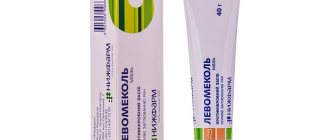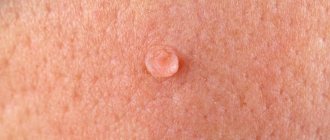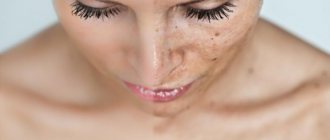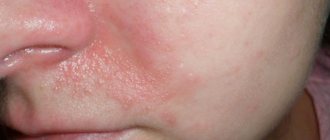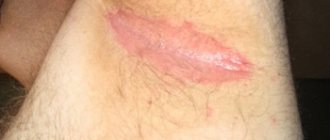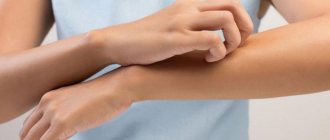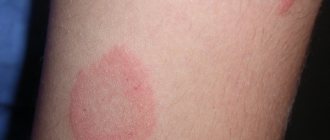Causes of skin irritation
Before talking about a cream against irritation and itching of the skin, you need to understand why these unpleasant phenomena occur. Among the reasons for their appearance are the following:
- Exposure to sunlight. Some people are susceptible to photodermatosis - increased sensitivity to sunlight. This phenomenon is represented by the following symptoms: hyperemia (redness) of the skin, the occurrence of severe itching and swelling. Additionally, even if a person does not suffer from photodermatosis, prolonged exposure to the sun usually causes the skin to become flaky, dry and red, and in some cases, a rash. Therefore, before sunbathing, you must apply sunscreens and emulsions.
- Frost and wind. During the cold season, the skin of the hands and face suffers from low air temperatures, wind and precipitation. In winter, tiny crystals form on the surface of the skin, causing microtrauma, itching and flaking. Therefore, before going out into the cold, you should not apply moisturizers to your skin.
- Dry indoor air. With the onset of the heating season, many people note that their skin becomes drier and begins to peel. This is due to a decrease in indoor humidity levels. To avoid this problem, it is recommended to additionally humidify the air in the rooms and apply a moisturizer to the skin to prevent itching and skin irritation.
- Insect bites. After biting or piercing the victim's skin, a particle of the insect's saliva enters the resulting wound. It contains substances that cause severe itching, redness and swelling of the skin. Antihistamine and hormonal creams and ointments help to cope with it.
- Contact with plants. Nettle, hogweed, buttercup and some other plants can cause skin irritation.
- Wearing tight synthetic clothing. Synthetic materials create conditions for the greenhouse effect. As a result, the body sweats, tight clothing rubs it and causes redness, microtrauma and skin itching.
- Presence of diseases of internal organs. Malfunctions of internal organs often affect the condition of the skin. Diabetes mellitus, kidney and liver diseases, thyroid diseases, neurological diseases, lymphoma, HIV - all this can cause skin irritation. In this case, the use of simple creams against skin irritation will not be enough; they can only act as auxiliaries.
- Skin diseases. A number of dermatological diseases are accompanied by skin irritation, itching, burning, swelling and hyperemia. For example, this applies to psoriasis, eczema, dermatitis, fungal skin infections, etc. To combat them, corticosteroid and non-hormonal creams and ointments are usually prescribed.
- Hormonal changes. Hormonal changes that occur during pregnancy, lactation and menopause often affect the condition of the skin. The same applies to hormonal imbalances caused by diseases of the ovaries, thyroid gland, pituitary gland and hypothalamus, and adrenal glands. The skin may become drier, prone to peeling, itching and the appearance of microtraumas, and lose its former tone.
- Allergy. Allergens that cause skin irritation can include cosmetics, household chemicals, food, medications, etc.
- Pregnancy and breastfeeding. While carrying a baby, many women complain of irritation of certain parts of the body or all of the skin. This is due to changes in the balance of hormones, as well as the pressure exerted on the skin by an enlarged abdomen. During lactation, complaints of nipple irritation may occur. These unpleasant phenomena are usually caused by irritation of delicate skin caused by mechanical trauma to the nipples, thrush or stagnation of milk. To combat them, creams that are safe for mother and child are used.
- Lack of vitamins and minerals. With an unbalanced diet, following strict mono-diets, as well as in the autumn-spring period, the body may receive an insufficient amount of vitamins and minerals. For example, a lack of iron, vitamins B1, B3, B6, D often manifests itself in the form of dry and flaky skin, itching and irritation. To combat these phenomena, vitamin and mineral complexes and normalization of nutrition are used. Also, necessary vitamins can be included in creams and ointments for the skin.
- Stress. Severe emotional shocks, unresolved internal conflicts and chronic fatigue are often the causes of skin irritation. The itching usually gets worse at night.
- Psychosomatic and mental pathologies. Anorexia and other forms of eating disorders, depression, and bipolar disorders can all cause skin irritation.
How to get rid of redness on the face
Irritation on the face
In pharmacies you can buy ointments that relieve irritation, but before buying a cream or ointment for redness of the skin on the face, you need to rule out possible diseases by contacting a dermatologist. If the doctor determines that rashes on the face, redness or the appearance of red spots are the result of dermatitis or other skin diseases, complex therapy will be prescribed for treatment. In this case, the treatment regimen, along with medications, will include an ointment for red spots on the face, which relieves the inflammatory process.
Ointment for red spots – Rozeks
In addition, the doctor will definitely recommend normalizing your diet and, until the acute phase of the disease is over, not using cosmetic powders, talcum powders, or correctors, so as not to increase skin irritation.
Attention! Do not scratch areas of the face affected by redness. This can lead to deeper infection, which can result in serious complications.
If damage to the skin on the face is accompanied by dizziness, pressure changes, enlarged lymph nodes, pain in the joints and feet, a comprehensive examination of the body should be done, as a result of which the causative agent of the disease will be detected. These could be diseases of internal organs, pityriasis rosea, or infection with infectious diseases, resulting in weakened immunity. In this case, a cream against redness on the face is not enough.
With pink lichen, the localization of its plaques can be on the skin of the neck, face and chest and abdomen. This disease affects men and women aged 20 to 40 years.
Pityriasis rosea
Cream for facial irritation
Unlike other areas of the body, which are usually covered by clothing, the face always remains open. In this regard, it suffers more from the effects of adverse weather conditions - exposure to sunlight, frost and wind. Men may experience irritation after shaving, so it is advisable for them to use special shaving creams and foams.
Irritation on the skin of the face is often caused by a reaction to substances contained in masks, peelings, foundations and decorative cosmetics - parabens, derivatives of formaldehyde and acetic acid, hydroxy acids, alcohols, etc.
To eliminate redness, peeling and itching of the face, creams for sensitive skin prone to irritation are usually used. They may include allantoin, retinol, hyaluronic acid, tocopherol, antioxidants, beta-glucan, herbal components (aloe vera, chamomile, verbena, green tea, algae polysaccharides).
Ointment for inflammation on the face with antibiotics
Ointments containing antibiotics are good for inflammation on the face. It is highly undesirable to use them without a doctor's prescription. There are general contraindications - allergies, fungal infections, pregnancy (for most), lactation.
It is important to use these drugs for a strictly defined period of time. With intermittent application of less than 5 days, microbes develop resistance, but do not completely disappear. With a long course (more than 2 weeks), the normal microflora of the skin is destroyed, which, after discontinuation, leads to a sharp deterioration in its appearance.
Synthomycin
The advantages of the drug are that it is a gentle base, can be used under makeup, and has no noticeable unpleasant odor. The composition contains chloramphenicol, better known as chloramphenicol. It acts on microbes that do not respond to tetracycline and penicillin.
Negative properties include an allergic reaction - burning, itching, rash; it can occur in the future when taking chloramphenicol orally. Apply no more than a week 2 times a day to clean skin. The price for a 30 g tube is 54 rubles.
Tetracycline
The antibiotic tetracycline is active against streptococci, staphylococci, and propionobacteria. Gives a lasting effect on acne. An ointment with a 3% concentration is applied to the rash covering 0.5 cm of healthy skin 1 or 2 times a day. The course of treatment lasts up to 10 days.
Prohibited for use by children under 10 years of age. Not recommended for treatment in the summer, as it increases skin sensitivity to the sun. Worsens the course of fungal diseases. Do not use with alcohol-containing solutions, soap, or pore-tightening products. Price for 30 g – 50-86 rubles.
Cream for irritation in the intimate area
Redness, itching and burning in the intimate area can occur for the following reasons:
- Traumatic methods of hair removal. Skin irritation is a common occurrence after hair removal in the groin area. It can be caused by using an insufficiently sharp blade, trauma to the skin, or ingrown hairs. A special anti-irritation cream for women after depilation in the intimate area helps eliminate discomfort.
- Diaper rash. This problem is mainly seen in infants due to wearing diapers, but can also occur in adults. For example, wearing tight underwear made of synthetic materials causes a greenhouse effect and irritation in the intimate area.
- Gynecological diseases. Many gynecological diseases are accompanied by redness, itching, dryness and burning in the vagina, perineum, and in the area of the labia majora and minora. In most cases, this is caused by a violation of the vaginal microflora, the growth of pathogenic microorganisms, and changes in hormonal levels.
- Failure to comply with intimate hygiene rules. Unreasonably frequent use of pads and their infrequent change, incorrect direction of the water stream during washing - all this creates conditions for discomfort in the intimate area.
- Allergy to personal hygiene products. If soap, creams, gels and foams that are not intended for this purpose are used for washing, there is a danger of disturbing the vaginal microflora. It usually manifests itself in the form of dryness, burning and itching.
To get rid of unpleasant sensations, you need to establish their cause. To do this, you should visit a gynecologist. If the prerequisite for the development of itching and burning are external causes (epilation, allergies), special treatment is usually not required. You just need to eliminate the irritating factor, and to reduce discomfort, use a cream against skin irritation in intimate places. Typically, such products include plant extracts and essential oils, panthenol and bisabolol.
If the cause of itching and burning is gynecological problems, specialized creams are used to treat them. Depending on the type of pathogen, the action of the main active ingredient can be directed against fungi, viruses, and bacteria. In addition to the antiseptic active component, such creams usually contain lactic acid, vitamins A, D, E, and local anesthetics.
What causes the skin to turn red?
The reasons for a red face when a medicinal cream is urgently required can be different - from a common reaction to frost or draft, to serious diseases that require medical intervention.
Common factors are:
- Genetic predisposition. Dermatologists say that red spots, as well as, in principle, a tendency to irritation, are inherited. If there is a grandmother in the family who suffers from such a problem, then with some degree of probability, the cosmetic defect will “go to” the daughter or granddaughter. This is often due to the characteristics of the epithelium and the structure of blood vessels.
- Allergy. In the age of active development of the chemical industry, allergens lie in wait for humans in a variety of places, from food to household personal care products. Dust, fur, cosmetics - all this can cause redness on the face, rashes and itching.
- The structure of the epithelium. The structure of the epithelium, as well as the location of the vessels, are considered individual causes. Usually girls of the European type with milky white skin are predisposed to redness.
- Incorrect care. In many ways, this factor depends on knowing the characteristics of your skin. But many girls do not take this attentively enough, choosing well-advertised decorative cosmetics or cheap ones.
- Frost and wind. Cosmetologists always warn women that the cold season is a real test for the skin. There is even such a thing as an allergy to frost - as soon as a woman (and a man) leaves the house, her face turns red.
- UV rays (sun) are another enemy of our skin. Today, when the sun is very active in summer, irritation and redness occur under its influence, and sometimes, abuse of sunbathing leads to serious burns of the epithelium. A passion for solariums can lead to exactly the same consequences.
- Bad habits. Smoking and the love of drinking a glass of wine “before bed” do not leave their mark on the skin. Redness gradually appears on the face, which can be difficult to get rid of.
- Hormonal changes. Pregnancy, menopause, and menstruation are often accompanied by rashes and redness.
- Skin diseases. They are different, but many are accompanied by redness, itching, pimples, and rashes. In these cases, you need to understand the cause only with your doctor.
- Consequences of acne and acne. Often, in place of deep pimples, unsightly spots remain, which greatly spoil the appearance.
It is clear that some causes cannot be eliminated without the help of a doctor and the redness will have to be treated in a doctor’s office (and maybe several). But you still need to take care of your skin every day, and it is better if it is a cream selected taking into account your skin type, which can, if not remove, then significantly reduce aesthetic defects on the skin of the face.
Cream for irritation on hands and feet
Dry skin on the hands is common. It is usually observed after exposure to the cold without gloves, contact with household chemicals, or washing hands with cold water. As for irritation on the legs, it usually appears after depilation, with diabetes, wearing tight shoes, and with dermatological diseases.
To combat unpleasant sensations, hormonal (corticosteroid) and non-hormonal ointments and creams are used. Corticosteroid-based products can remove signs of irritation - effectively and in a short time. However, such creams are prescribed only in serious cases, since their uncontrolled and prolonged use can be dangerous to health. Non-hormonal creams and ointments are not able to cope with serious irritation, which is accompanied by inflammation. But at the same time, they fight well against mild forms of itching and flaking due to their antihistamine components, plant extracts and local anesthetics.
Cream for irritation on the skin of the face and body La-Cri
To combat skin irritation represented by dryness, flaking, redness and itching, you can use La Cree Cream for Dry Skin. The cream contains natural ingredients: shea butter, jojoba and wheat germ, beeswax, string and licorice extracts. These active components improve the water-lipid balance of the skin, fight irritation, nourish and moisturize the skin, make it elastic and firm. This product is not only great for adult skin care, but can also act as a children's anti-irritation cream.
Soda
A variety of masks, lotions, and creams are made from soda. They are most effective in eliminating red rashes.
Together with salt, the product gives maximum effect on the affected areas of the skin. Due to their aggressive influence, cellular regeneration is accelerated.
The most popular means:
- Mask of soda and salt. The components are mixed in equal proportions. Before applying the mask to your face, you need to prepare it: wash it and lather it with baby cream. Then the product is applied over the soap. The face is massaged, but not rubbed. The mixture lasts for about a quarter of an hour and then is washed off with water.
- Salt, soda and cleansing gel. Take 2 tsp. gel, beat thoroughly. Add 1 tsp. salt and soda. Cleanse the face, wash with water and apply to inflamed areas. The procedure lasts no more than a few minutes. After manipulation, a cream suitable for the skin type is applied.
- Salt and soda are mixed in equal proportions and olive oil is added. It directly protects the skin from the aggressive influence of other components.
- Mix soda and salt, add 2 tsp. sour cream. The mask is applied to red spots for 5 minutes. Already after the first procedure, significant improvements will be noticeable on your face.
- Oatmeal and soda. Before cooking, the flakes must be ground in a coffee grinder. A glass of oatmeal is mixed with 1 tbsp. l. soda The mixture is diluted with water until a porridge forms. The product is applied to the surface of the face for a quarter of an hour. Then the mask is washed off with cold water and treated with cream.
- Soda and honey. Honey softens the skin. Soda helps eliminate pathogenic microflora. 3 tbsp. l. Soda is mixed with half a glass of water. Add 1 tbsp to the mass. l. honey and mix well. The mask against red spots after acne remains on the face for 15 minutes.
These recipes help to quickly and effectively get rid of red spots after acne on the skin of the face and body.
Clinical researches
As a result of clinical studies conducted, it was confirmed that La-Cri cream for dry skin:
- eliminates dryness and flaking
- retains skin's own moisture
- protects skin from wind and cold
The conducted clinical study proves the high efficiency, safety and tolerability of products for daily skin care of children with mild and moderate forms of atopic dermatitis and during remission, accompanied by a decrease in the quality of life of patients. As a result of therapy, a decrease in the activity of the inflammatory process, a decrease in dryness, itching and flaking was noted.
Consumer Reviews
Nafisa (proberry.ru)
“Today my review will be about the La Cree cream for dry skin. The brand is new to me. The cream was a pleasant surprise. First of all, it does not contain fragrances or dyes. Can be used even for children. Our skin is constantly exposed to the environment, so it needs nutrition and care. Both in cold weather and in summer heat, people with dry sensitive skin should apply nourishing and moisturizing creams. La Cree cream is perfect for this purpose. It contains licorice and violet extract, jojoba oil, shea butter, wheat germ oil. When used, it saturates the skin with healthy fats and moisturizes it. Softens and gives elasticity to the skin. Has anti-inflammatory properties. I will use this cream during the cold season.
What I liked:
La-Cri Cream for dry and sensitive skin I liked the cream because it absorbs well and softens the skin.”
Sources:
- Andropova T. V., Gudina M. V., Odintsova I. N., Hygiene of children and adolescents, Siberian State Medical University Publishing House, 2021.
- Cohen Bernard A. Pediatric dermatology, MEDpress-inform, 2015.
- Bonifazi Ernesto, Differential diagnosis in pediatric dermatology, Panfilov Publishing House, Binom. Knowledge Laboratory, 2014.
